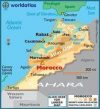Trade between Morocco and the rest of the continent has grown steadily in recent years (+ 20%, or more than US$ 1.5 billion), says the African Development Bank (AfDB).
The Bank made the assessment in its second volume of Analysis of Morocco’s Trade Policy titled ‘Impact of Morocco’s tariff policy on its position as a hub for the rest of Africa’. The publication offers a targeted analysis to determine whether tariff policies between the Kingdom and the other African countries would promote the development of trade among them.
Sub-Saharan Africa, with an average growth rate of about 6.3% during the 2000s (world record after Asia), offers an increasingly attractive economic outlook and market.
Still, the volume of trade remains modest in absolute terms: Sub-Saharan Africa now accounts for just over 6% of Moroccan exports and just under 1% of its imports (compared with 5% in 1993). Reversing the picture reveals even lower figures: Morocco, as a destination for African exports, occupies 95th place, with only 0.05% of the region’s exports (compared with 0.07% in 1993 and 0.36% in 1998).
And the country ranks 62nd among the continent’s products importers, accounting for 0.27% of total African imports (compared with 0.07% in 1993). The Kingdom imports coal (15.8%), coffee (13.6%), livestock feed (11.2%), spices (6.2%) and inorganic chemicals.
Low volume but intense trade transactions
While trade remains weak in absolute terms, they are of very high-intensity with some countries which are therefore relatively important partners for Morocco: Senegal, Equatorial Guinea, Ghana, Angola, Guinea, Côte Ivory Coast (the AfDB’s headquarters and to date the continent’s main destination for Moroccan investments), Togo and Egypt.
With regard to Morocco’s exports, 13 African countries are among the 28 partner countries with which trade intensity was significant between 2011 and 2013: Guinea, Senegal, Equatorial Guinea, Côte d’Ivoire, Ghana, Togo, Angola, Nigeria and Mauritania in Sub-Saharan Africa; And Tunisia, Algeria, Libya and Egypt in North Africa.
On the import side, the index of these exchanges is greater than one with seven African countries (of the 22 partner countries): Togo, Senegal, Malawi and Cameroon; As well as Tunisia, Algeria and Egypt.
Customs duty regime reveals the African Paradox
Both Morocco and many other African countries have renegotiated their tariffs with countries and regional blocs in Europe, Asia and America. On the positive side, this enabled them to facilitate their respective commercial relations with their partners and destinations of choice.
However, this has resulted in a paradox in that it has become easier for them to trade with Europe, Asia or the United States than with their own neighbours and continental peers.
In fact, the difference between Morocco’s average tariff rate with European countries and the average tariff applied to African countries is about 17 percentage points. African countries, on the other hand, apply to their Moroccan imports customs tariffs higher by 3 or 4 points on average to the tariffs applied for their imports from Europe or the United States.
Admittedly, Morocco has significantly lowered its tariffs in recent years on products from sub-Saharan Africa (-78%, 39 percentage points less since 1993). But this decline did not translate into an increase in exports to that region.
Reducing Moroccan customs duties on products imported from sub-Saharan Africa would help boost their exports to Morocco.
It is projected that cutting these tariffs by half would lead to a 20% increase in imports from sub-Saharan Africa, according to AfDB. Currently relations between Morocco and the rest of the continent are intensifying. The Kingdom, which has just returned to the African Union and announced its intention to join the Economic community of West African States (ECOWAS).
No real trade policy without tariff reduction?
Similarly, halving the customs duties of the ECOWAS, Morocco’s main economic partner in Africa, would result in an increase of about 5% in Moroccan exports.
And they would increase by 15% in the Common Market for Eastern and Southern Africa (COMESA) countries with an identical reduction in tariffs; And 23% in the Economic Community of Central African States (ECCAS). More importantly, Moroccan exports could reach 40% in the case of the East African Community (EAC)!
The AfDB’s publication, therefore, highlights the fact that tariff reduction remains a key trade policy tool on the continent. And if the tariffs applied by Morocco and by its partners in Africa (especially sub-Saharan Africa) were to be renegotiated, it would undoubtedly increase trade for the benefit of both parties.
The publication with seven chapters devoted to the competitiveness of Morocco’s tariff policy follows the first volume which focused on the impact of the country’s tariff policies. A third forthcoming volume will seek to identify categories of export products that could benefit from an increase in trade between Morocco and other African countries.

